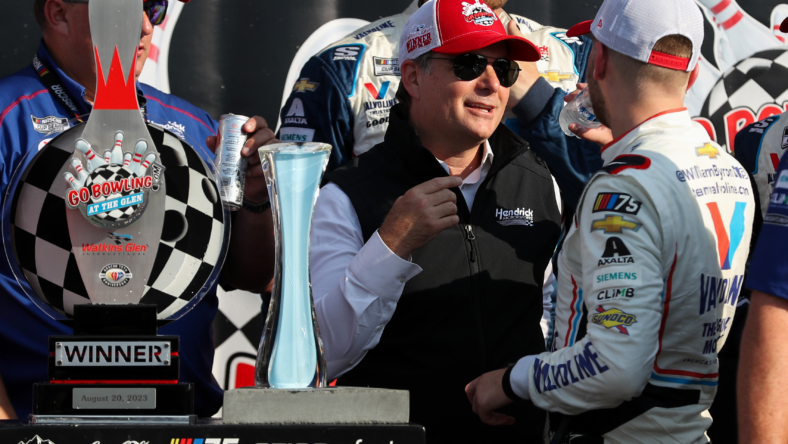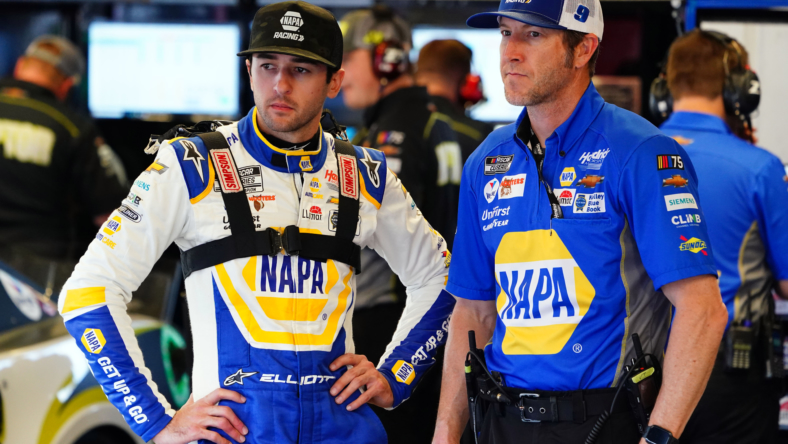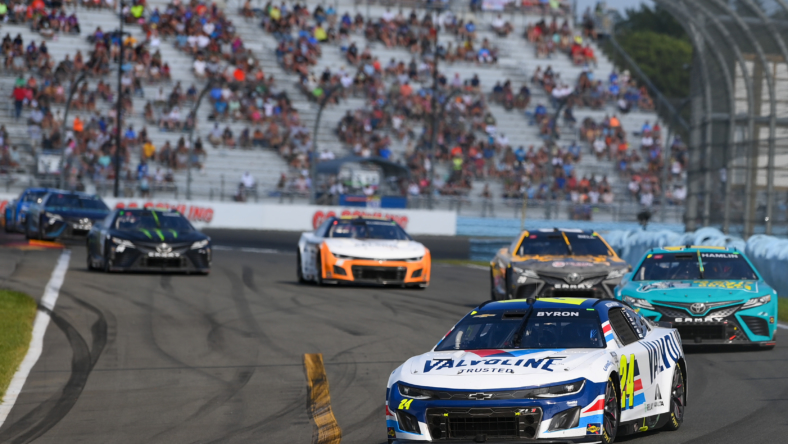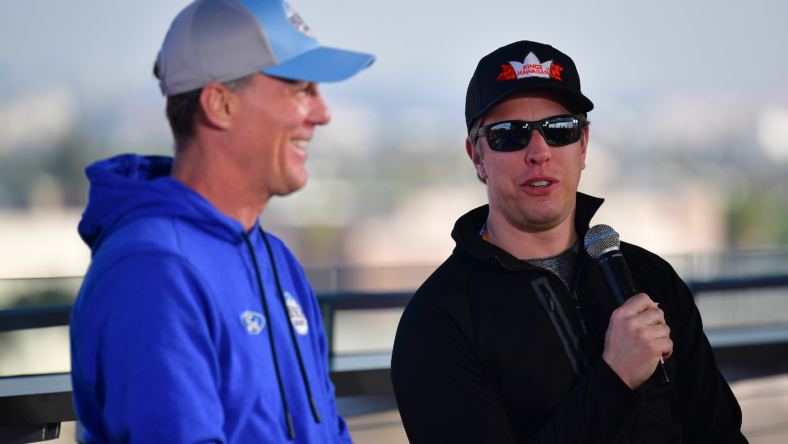It was a familiar sight, the driver of the Hendrick Motorsports No. 24 in Victory Lane at Watkins Glen International being handed a cell phone with team owner Rick Hendrick on the other end of the line. No, this wasn’t Jeff Gordon, although he was there too celebrating his successor William Byron on a five-win-and-counting breakout season.
The cell phone thing was something the NASCAR community was frequently treated to in the late 1990s and early 2000s as Gordon and the No. 24 team ran roughshod over the competition — Mr. Hendrick frequently calling into the celebration remotely.
It’s funny how history repeats itself.
Byron had won four races over the past three seasons, one each in 2020 and 2021, before adding two more in 2022, but this is his true breakout. It mirrors Gordon in 1995 when he won seven times en route to his first championship after a two-win season the year before.
Gordon is admittedly so old he can’t draw the parallels but he does see a driver is absolutely capable of doing some of the same things within the modern context.
“It’s hard to go back 30 years and remember how that went down, but I do love what I’m seeing,” said Gordon on Sunday, now the vice chairman of Hendrick Motorsports. “For us internally, it’s just been this nice progression to see he and Rudy (Fugle, crew chief) clicking and the whole team just coming together this year.”

Gordon also won four times at The Glen from 1997 to 2001, the championship years, and maybe that’s another parallel between them.
“Yeah, it’s cool because I spent a lot of time watching summer races here with that flames car and how good he was here at the Glen,” Byron said. “Him and Tony Stewart basically all the time. Yeah, it’s great to carry on that legacy with the car, and we’ll share a couple of memories over it.”
It’s also an important win for the No. 24 team because, for the second year in a row, they’ve kind of hit a summer slump. Last year, the team just struggled to find pace and the results showed it but this year, the speed has been there, but the execution has been off.
So, winning two weeks before the start of the playoffs builds the kind of momentum they need to carry them forward into the chase for the championship.
And with 28 playoff points, Byron is the current leader but will probably fall to second in the seeding after this weekend with the bonus points Martin Truex Jr. is set to accrue by virtue of his regular season championship.
Either way, Byron is a favorite to make it to the championship race in Phoenix and that’s Gordon-like from the current driver of the No. 24.
Mistakes sink Chase Elliott

Chase Elliott said it best on Saturday about his chances to win his way into the playoffs over the final two weekends of the regular season.
“To show up there and be in a must-win situation is like going to Vegas and having to hit the nearest slot machine for the jackpot,” he said. “That’s just silly.”
So here we are.
Since then, Elliott failed to qualify his way into the pole round and started the race in 15th as a result. Needing to find some way to make up for the lost track position in time trials, crew chief Alan Gustafson called Elliott to pit road as soon as their pit window opened and it netted them about seven positions.
However, approaching the end of the second stage, Elliott lost fuel pressure and Gustafson immediately told his driver that their internal calculations were off and they simply ran out of fuel. Just like that, Elliott was one lap down and was a non-factor for the rest of the afternoon.
He is going to Daytona, that figurative Las Vegas, effectively needing to hit the jackpot to pay the bills. It’s silly but it’s their reality in their regular season race.
Speaking to a small group of reporters that included Frontstretch.com, FOX Sports and NBC Sports, Gustafson fielded questions on his way out of the track about what happened.
“You can’t do the same thing as everyone else and expect a different result, right,” Gustafson said of his alternate pit strategy.
What was behind the miscalculation?
“That’s internal stuff,” he said. “I’m not going to go over our internal stuff in the media.”
Did he anticipate running out of gas?
“I’m not going to go over our internal stuff in the media and I’m not going to educate everyone else on the problem,” he said.
But he did say, after they qualified outside of the top-15, that it was going to take a big strategic deviation to give them any chance of winning and the ultimate outcome was always part of the gambit.
“To win, you have to have very thin margins,” Gustafson said. “You have to exploit everything to the highest percentile possible. Anytime you’re trying to push, yeah, you’re cutting margins. That gets riskier and riskier.”
So now, Gordon has two drivers facing must-win odds with just one race and one spot left, at Daytona of all places. It’s also the two drivers who are only in this position because they missed time due to injuries sustained doing extracurricular activities.
“The 48 (Alex Bowman) was just off,” Gordon said. “I haven’t really downloaded with them. They were off. I’m not sure how they lost some of the track position.
“But clearly miscalculation with the 9 (Elliott) car, and that was huge. He was stretching — he came in a little bit short the first stop and so they were trying to stretch it to get closer on the strategy of the others.
“You always want to pad yourself here just in case there’s a lot of restarts at the end. The fuel just wasn’t there. It was really unfortunate.”
It was just a miss by the entire No. 9 team this weekend, from the driver in qualifications to the crew chief and their analytics department on the timing of that first pit stop.
Related: High stakes for everyone in NASCAR’s regular season finale
Another procedural road course race

If not for Elliott running out of gas, the Cup Series would have gone an entire race without a single caution, and nearly two whole races when considering there was only a single caution at the start of the Indianapolis Motor Speedway road course last weekend.
In fact, Sunday’s race at Watkins Glen was so otherwise uneventful and procedural, that it was the shortest race of NASCAR’s modern era at one hour, 58 minutes and 44 seconds. It was the quickest race since a 1971 100-miler at Hickory Motor Speedway in North Carolina that took one hour, 22 minutes and 25 seconds.
This was a byproduct of a couple of factors.
For one, NASCAR removed the stage breaks on road courses this season due to overwhelming feedback from within the industry and fanbase. But there’s also no question that this second-year car continues to struggle to produce action on road courses and short tracks.
It’s been a talking point all season.
“This is not breaking news (but) any track that is single-lane is where the NextGen struggles,” Hamlin said. “It has to get out of the wake of other cars. With lap times only falling off a second over the course of an entire run on a track this big, we’re all on the gas, hammer down, and passing is really hard.”
AJ Allmendinger says this is why the top-five cars were just locked in place all day Sunday.
“It’s just super hard to pass,” Allmendinger said. “Everyone is so close (on lap times) at the front. Tires don’t fall off a lot. You just have to force guys into a mistake and when you’re racing the best drivers at this discipline, it’s hard to do that.”
Gordon agreed with that assessment but also said road course races this year have taken on a throwback flair.
“Honestly, I watched that race today and I felt like I was watching races from the ’90s,” Gordon said. “To me it was the kind of race that you used to see at road courses.
“I laugh because throughout my career, I remember a time where people were saying, ‘why do we have two road courses (because) the road course races aren’t very good,’ because it got so strung out.
“Then we went to double-file restarts and then we went to stage racing and all of a sudden the road courses were unbelievable and amazing.
“Now I think we’ve gotten better on the mile-and-a-half (tracks) and I think the superspeedways seem to be really good but the short tracks and road courses need a little bit of work. NASCAR is certainly aware of it, and they’re trying some things to sort that out.”
To wit, NASCAR has been developing a variety of aerodynamic solutions for short tracks and road courses from the current low downforce package to removing the rear diffuser and the development of a lift splitter.
These are all changes designed to offset the aerodynamic advantage that a leading car has in clean air.
“It’s just hard to get close to the car in front of you to then be able to dive bomb them and make some of these risky moves that then might turn into more cautions,” Gordon said.
Keselowski, Harvick lock in

Since Byron was a repeat winner, and with only one regular season race remaining, it’s no longer mathematically possible for anyone to catch Brad Keselowski or Kevin Harvick on points … nor could a new winner next weekend at Daytona eliminate the pair of former winless champions.
They’re locked in.
This is especially rewarding for Harvick because these next 11 races are his final at the Cup Series level before setting sail into retirement. Thus, the 2014 champion will have a chance to pull a Peyton Manning and retire as a champion.
“I wish we could have won a race before now but we’ve had our opportunities to win a few of them,” Harvick said. “We’ve struggled on road courses but other than that, (our season) has been strong.”
How does he feel about his playoffs chances?
“We need to get our cars driving better if we’re going to do anything.”
Keselowski, the 2012 series champion, missed the playoffs last year in his first season as a driver and co-owner of RFK Racing. His teammate, Chris Buescher, has won twice and they are sixth and seventh in the championship standings, respectively.
Now, both the No. 6 and 17 cars will race for a championship, the first time the former Roush Fenway Racing has placed two cars in the playoffs since 2014 with Carl Edwards and Greg Biffle.
“I felt like we were making progress this time last year and it just wasn’t as visible as it is here today,” Keselowski said. “To have our cars sixth and seventh in the points and you feel the progress and momentum building, it’s an exciting time for us at RFK.”
Matt Weaver is a Motorsports Insider for Sportsnaut. Follow him on Twitter.
